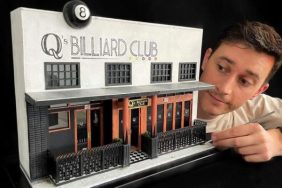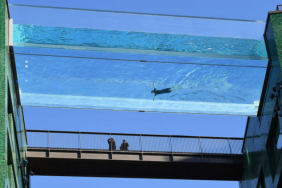Frank Gehry, “Walt Disney Concert Hall Project Model, 1989-2003 (competition 1988)”, Los Angeles, California, 16 x 36 x 48 in. Gehry Partners, LLP, Los Angeles, © Gehry PArtners, LLP, Image courtesy Gehry Partners, LLP.
The works of architect Frank Gehry is on display in an exhibition entitled Frank Gehry, presently on view in LACMA’s Resnick Pavilion until March 20, 2016. As one of the greatest contemporary architects, Gehry’s genius is portrayed in terms of his originality, but also his technicality – specifically his adeptness with the design software CAITA. As the first architect to use CATIA, Gehry’s affinity for and pioneering of the software opened up a sea of possibilities for other architects and contractors.
Also: Exhibit | Masood Kamandy – Record. Collect. Compose.
Crave had the opportunity to send questions regarding the new exhibition and Gehry’s influence to LACMA senior curator and department head Stephanie Barron, who compiled the answers working closely with her assistant curator Lauren Bergman.
Crave: What materials did Frank Gehry use that were new to architecture and how did he combine his knowledge of design and safety to ensure their use?
Barron/Bergman: Early in his career, Gehry used economical, industrial materials such as galvanized chain-link fencing, corrugated metal sheeting, cardboard, and asphalt in unconventional ways. For example, in the design of the Gunther Residence (1978, unbuilt, Malibu, California), Gehry surrounded open-air decks and terraces with chain-link fencing that shielded the intense glare of the site’s southern exposure while preserving spectacular views of the ocean. Gehry has continued to experiment throughout his career with new materials for which he engages in multiple tests to ensure the material’s safety and effectiveness. For the National Art Museum of China (2010-12, unbuilt, Beijing, China), for instance, he proposed a compact volume bound by a double skin made of a “translucent stone” that evokes the preciousness of jade (the glass is treated by a process specifically developed for this project). The space between the glass layers, on which films can be projected, delivers optimized energy-saving properties such as natural ventilation, thereby reducing the building’s environmental footprint.

In what new ways did he use CATIA for architectural design, and why do you think other architects did not also use this tool prior to him? In what ways did he expand the tools to create and design his structures?
By the late 1980s, two-dimensional construction plans were no longer adequate for realizing Gehry’s increasingly complex geometric forms. The construction of the Vitra International Furniture Manufacturing Facility and Design Museum (1987–89, 1998, Weil am Rhein, Germany) had failed to meet the architect’s expectations. Gehry worked with Dassault Systèmes to adapt for his needs their software CATIA (Computer Aided Three-Dimensional Interactive Application). His unorthodox forms—much like the airplanes and ships for which the design software was originally created—were articulated most effectively through this three-dimensional modeling.
Gehry applied this digital approach first on the fish sculpture for the Olympic Village (1989–92, Barcelona, Spain) and the Nationale-Nederlanden Building (1992–96, Prague, Czech Republic) and then on the unrealized Lewis Residence project (1989–95, Lyndhurst, Ohio) and the Guggenheim Museum Bilbao (1991–97, Bilbao, Spain). In 2002 he founded Gehry Technologies, dedicated to the research and development of new software and programs to aid design. This new company created an add-on to CATIA called Digital Project, which is now used by architects all over the world as a bridge between the architect—who could remain at the center of the project from conception to construction—and the building contractors, who could estimate costs more accurately and produce unorthodox forms. Without this major advance in the field, some of Gehry’s most iconic buildings, such as Walt Disney Concert Hall and Fondation Louis Vuitton, could not have been constructed.
What’s an example of a structure in Los Angeles that Gehry designed using CATIA?
One of the best examples of Gehry’s use of CATIA would be Walt Disney Concert Hall (1989-2003 (competition 1988), Los Angeles, California). Home to the Los Angeles Philharmonic, this concert hall has become an icon of the city. Sited diagonally on the 162,000-square-foot site, the project breaks the block’s rectilinearity, allowing a variety of viewpoints and creating a striking entry plaza. As the two models on view will illustrate, much changed during the planning stages, including the building’s shape, cladding materials, and foyer size; a hotel and chamber-music room were also eliminated. The dramatic orientation, open entrance, and gardens—considered to be the plan’s hallmarks—remained, however. Gehry designed the interior concert hall based on extensive acoustics studies and mock-ups, as well as the client’s desire that the audience surround the orchestra. While the hall holds 2,400 seats, its design and its exceptional acoustics creates an extraordinary, intimate experience.

How is the LACMA exhibit unique in terms of artwork and photos presented?
Organized by curators Frédéric Migayrou and Aurélien Lemonier at the Centre Pompidou, Musée National d’Art Moderne, Paris, and adapted for LACMA’s presentation by Stephanie Barron, senior curator and department head of Modern Art, with Lauren Bergman, assistant curator of Modern Art, Frank Gehry traces the full arc of the architect’s career, with his revolutionary urbanist projects at the exhibition’s center. Gehry’s design process originates with free-form sketches whose emotive, continuous line captures the energy of the building as it distinguishes forms and spaces. He and his team at Gehry Partners, LLP then produce models in various scales that he can manipulate by hand. His immediate, direct relationship with his models and sketches—the exhibition features over 200 drawings, many of which have never been seen publicly, and more than 65 models—reveals the arduous and contemplative design process of one of today’s most extraordinary architects.
LACMA’s presentation of Frank Gehry includes an additional gallery, Gehry Partners: In the Studio Now, featuring several projects currently being designed or constructed. This body of current work reveals his unique ability to consistently evolve and conceive of new forms and materials deployed in original ways. For example, while known for his striking exteriors, for Facebook’s West Campus Building (2012–15) in Menlo Park, California, Gehry devised a 430,000-square-foot, single-level office space whose rooftop is a sprawling ten-acre garden that camouflages the building from above. For Gehry, it is imperative to keep pushing boundaries: “You can’t redo old ideas . . . you can learn from the past but you can’t continue to be in the past. I cannot face my children if I tell them I have no more ideas and I have to copy something that happened before. It is like giving up and telling them there is no future for them.”
What does Gehry have planned?
Gehry has multiple projects that are in the process of design or construction. The gallery Gehry Partners: In the Studio Now will highlight these future projects, including, among others, Facebook, West Campus Building (2012-15, Menlo Park, California, King Street West Development (2012-present, Toronto, Canada), 8150 Sunset (2015-present, West Hollywood, California), and the Dwight D. Eisenhower Memorial (2009-present, Washington, DC).

Who are the curators and what is the connection to Los Angeles County Museum?
This exhibition is organized by curators Frédéric Migayrou and Aurélien Lemonier at the Centre Pompidou, Musée National d’Art Moderne, Paris, and adapted for LACMA’s presentation by Stephanie Barron, senior curator and department head of Modern Art, with Lauren Bergman, assistant curator of Modern Art. When LACMA learned that the Centre Pompidou was organizing a retrospective of Gehry’s work, we immediately contacted them about its traveling to his hometown. LACMA and Gehry have an extensive history together, dating back to 1965 and his first exhibition designs for the then-newly opened museum. He has since designed ten more exhibitions throughout his career, just recently for Ken Price Sculpture: A Retrospective (2012-13), and Calder and Abstraction: From Avant-Garde to Iconic (2013-14). Gehry is one of this city’s true cultural icons, and it is a great honor to adapt the Pompidou exhibition for a Los Angeles audience.








